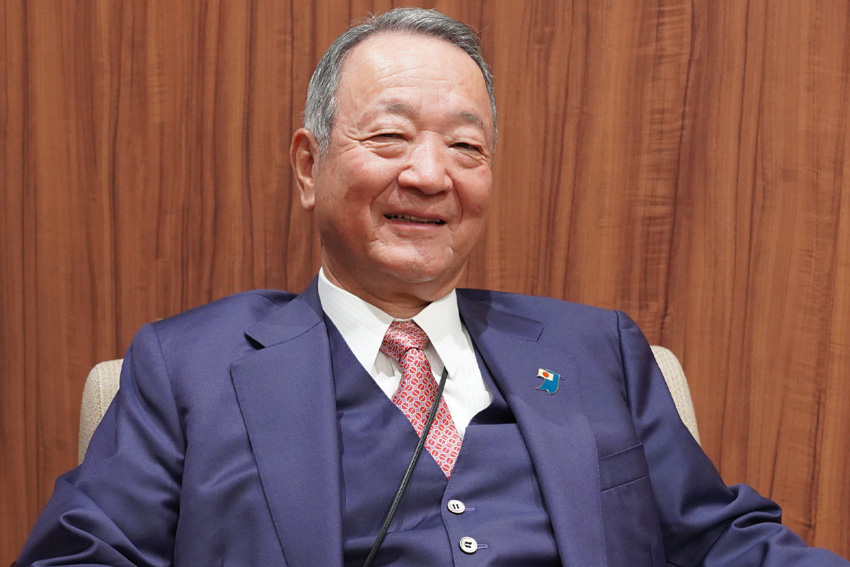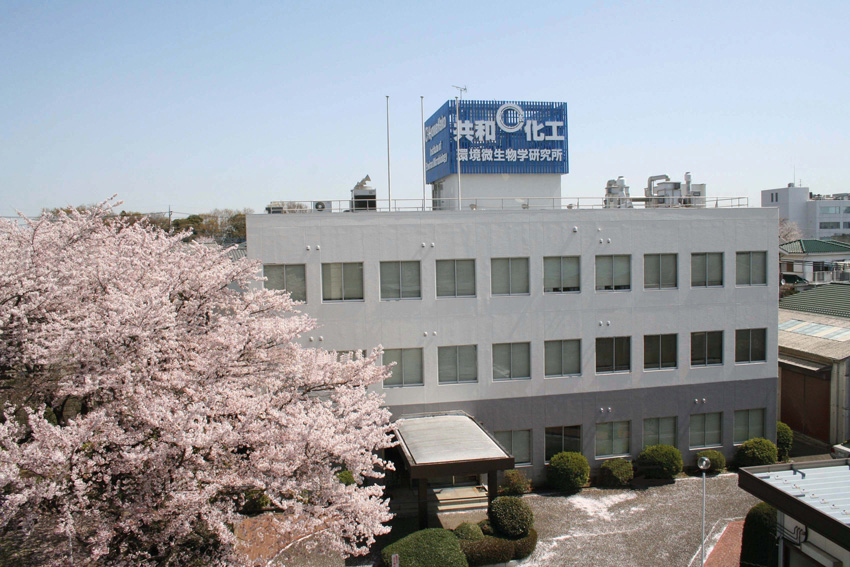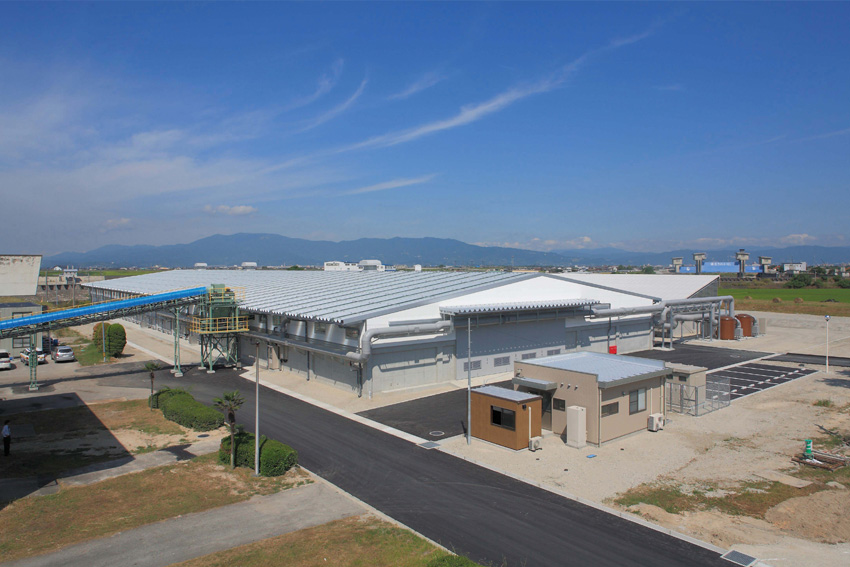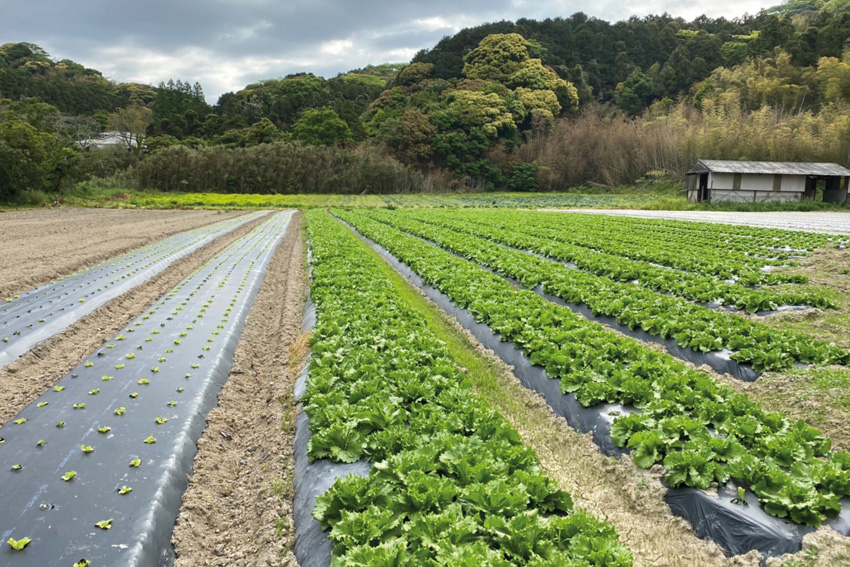Adoption of Kyowa Kako's cutting-edge technologies will naturally result in a decreased reliance on chemical fertilizers.

Can you give us an introduction to your company?
Our company was established in 1959, and we recently celebrated our 65th anniversary on the 26th of January. Earlier in your introduction, you mentioned interviewing other companies which operates in this sector. Those companies do not necessarily focus on environmental services. However, our core value is to focus on the soil and the related microorganism as well as the environment around it. That was how our business developed.
I am the third-generation president of this company. Up until the second generation, it was a family-run business. I am the first president from outside the family and I have made some changes to the company. A few years ago, we had an interesting meeting with a European company, which also has operations in Japan. The president of the company in Japan at the time came to visit our company. Japan traditionally had been incinerating 93% of the sludge generated from sewage treatment, whereas in the US and France, most of the waste was landfilled. The treatment of the sewage sludge in the landfill was causing issues. The untreated leachate coming from the landfilling process can cause soil degradation which impacts agriculture, and also can be hazardous that this leachate can contaminate the groundwater and consequently seeping into drinking water and causing harm to people. The US and France recognized these issues and decided to change their systems to incineration or to the microorganism treatment of the sludge that our company has been doing in Japan. Because of this challenge that many countries around the world are facing, the president of the European company in Japan came to visit us to learn about our technologies.
I entered this company 53 years ago, so I have been working in this industry for more than half a century. In the beginning, my focus was wastewater treatment. Once you treat the wastewater, you get sludge coming from the biological treatment, which was then either incinerated or landfilled. However, 25 years ago, I came up with the idea to conduct material recycling for this sludge and contribute to the agricultural sector by providing recycled fertilizer to enrich the soil and increase the yield. Since then, we have been focusing on the microorganisms that have led to YM bacteria. Generally speaking, there are three categories of living organisms. The first is an ancient type of microorganism. The second is a newer type of bacteria, and the third is human beings and animals. Within these three categories, it is classified into humans, animals, plants, and fungi which are aerobic organisms.
YM bacteria is part of the ancient microorganism family, of which it is believed that only around 2 or 3% of its microorganisms have been discovered. More than 95% of these microorganisms have not been understood yet by the Scientific Society. By fully leveraging the blessings of this microorganism, we have developed ways to recycle and produce a soil-enriching material that can be spread on the land to increase the harvesting of rice, vegetables, and other cultures. Since the founding of the company, we have been working towards the cleansing of the environment. However, 25 years ago, we shifted our perspective more toward agriculture, and we have been contributing to the increase of the agricultural field since then.
This is a photograph of myself and Former President Duterte of the Republic of the Philippines. I first met him when he was the mayor of Davao City through a common acquaintance with a professor from the University of Tokyo. We were able to provide a solution of biodegradables treatment technology through a partnership with a local private sector company to produce good quality fertilizer and help increase the yield per hectare on the local agriculture in some crops. He was very passionate about boosting agriculture in Mindanao Island, and we were able to do so through our Hypethermophilic Aerobic Composting Technology of biodegradables. At that time, we already had transactions with Korea and China. The Philippines was the first Southeast Asian country interested in our technology.

Institute of Environmental Microbiology
Waste management is an issue that governments around the world need to tackle. The Philippines produces a lot of organic waste generated through its agriculture and fruit processing plants. Therefore, they require a lot of chemical fertilizers and organic fertilizers too. However, they do not have a stable and safe supply and production of organic fertilizers locally. They face challenges in organic fertilizer supplies and are also inclined to search for more composting technologies to turn biodegradables into organic fertilizer. At that time, the Former President of the Philippines Rodrigo Duterte was introduced to a new technology to tackle the issues of waste management in the agricultural sectors.
The composting activity is currently a very popular theme in the food security and biodegradables waste management fields. This activity englobes several sectors on its own regulation: Waste management, Environmental and Infrastructure sectors such as Sewage Treatment Regulations. However, in the past, Japan had a differentiated bureaucratic structure, and the Ministry of Agriculture, the Ministry of Environment, and the Ministry of Land, Infrastructure and Transport all had their own regulations. This made it very difficult to pursue the composting project. This same issue also applied to the EU. To overcome these hindrances, over the past 25 years, we have been investing privately to create a material in this organic waste recycling system that we can showcase to local governments. We currently have this Hyperthermophilic Aerobic Composting Technology operating in 43 locations in Japan. Per day, we can treat 600 tons of food waste and sludge from sewage treatment and other wastewater treatment processes, which equates to treating approximately 210,000 tons per year of organic wastes. Of this, around 20% is converted to organic fertilizer. This accounts for over 40,000 tons of fertilizer production from waste per year. We take this organic fertilizer to the local farmers to prove its effectiveness in better agricultural production, sometimes resulting in increasing the yield of rice and other crops. Through this process, we are slowly but surely creating examples of success that we can use to convince the local governments to create a sewage sludge recycling scheme for soil enrichment to increase agricultural production and sustainability.
When our employees graduate from university and enter our company, during the training period they go out to the fields outside of Tokyo to learn about the local agriculture and usage of the organic fertilizer that was produced in our Hyperthermophilic Aerobic Composting Technology. Usually, a company that centers around the environment has a business scheme that the main income is coming from providing environmental services or sales of related machinery. However, we are trying to create a new type of business aimed at achieving SDGs and CO2 emission reduction in the waste management and agricultural chains combined, which have separated regulations, financing fields and business aims. This is such a pioneering case that it can be difficult to get the budget from the private sector and even from the public sector. To overcome this, we lease the money from the bank, and we invest in our technologies and businesses. That is why we are not a big revenue company.
We track the soil elements at our Institute of Environmental Microbiology to learn more about the types of microorganisms that are present in the soil. It allows us to see the changes in the soil after applying our organic fertilizer and investigate the consequences on the crops. Furthermore, we compare the vegetables that have been harvested with organic fertilizer with those that have not and investigate the differences in the texture and taste of the produced vegetables.
Through the research that we have conducted, we have been releasing academic papers that have been highly praised by the scientific community in this field. There are many good researchers when it comes to soil, agriculture, and sewage treatment. However, while they may be logically correct, I consider them fiction as they have not actually traced deep into the core. We were able to patent a copyright that says that “microorganisms do not lie.” A few years ago, there was an International Water Association Congress held in Tokyo, and during a meeting that I attended with several scientific related experts in Japan I explained that through working with microorganisms, you can really see the non-fictional world.

Hyperthermophilic aerobic composting plant
In seeing your technologies, it is very impressive to see how you managed to conquer the food and agricultural fields. While your main focus remains on these fields, are there any other fields or businesses that you would be able to help through your services and technologies?
Our company specializes in microorganisms of which there are so many diverse applications. However, we are currently focusing on the agricultural field as it is a very holistic and diversified field. For example, growing a leafy vegetable and growing a root vegetable are very different. Also, when you grow a melon in Japan, for example, you only use the cropland every other year. However, it was observed that when using a good quality organic fertilizer and the right quantity applied during the cropland preparation, this can continuously grow melons for consecutive years. This is due to the high potential of the enriched soil that we can provide to recover the cropland which was used for extensive harvest. Our fieldwork is very deep and has several variables. We continuously conduct research on microorganisms as there are so many things that we need to learn to find ways to leverage by ourselves.
Japan is facing a huge challenge when it comes to self-sustaining agriculture. The self-sustenance rate in agriculture to produce food for the population in Japan is only 58% and the caloric base is only 38%. This means that we can only feed one-third of the population with food produced from within Japan. A few years ago, the Japanese Ministry of Agriculture introduced a new strategy for the “Strategy for Sustainable Food Systems, MIDORI”, which called for the utilization of 4 million hectares of agricultural land for food production based on sustainable agriculture and organic related fertilization. One million hectares was to use organic fertilizers coming from livestock manure and three million hectares was to use an environmentally friendly system of agriculture including the widespread usage of organic fertilizer coming from organic waste treatment. Also, two years ago, Prime Minister Kishida stated that the use of fertilizers from sewage sludge treatment in agriculture was necessary. This statement removed the hindrances that were limiting the growth of fertilizer from sewage sludge treatment.
For the past few years, we have been trying to convince the Japanese Agricultural Cooperatives (JA) which controls local agricultural produce to change their policy on the use of organic fertilizer. JA does not allow in several locations agricultural produce that uses organic fertilizer from sewage sludge to circulate in the local agricultural system. It is the responsibility of the local farmers to purchase the organic fertilizers coming from sewage sludge by themselves. We want to create a system where farmers who use our sanitary safe organic fertilizer from sewage sludge can sell their produce to us or to the market. This includes rice, sake, and flour. With the shift in the mindset of the Japanese government, we have high hopes for the future.
Can you tell us more about your YM reactor?
Our YM reactor is a very specialized technology that allows the activation of bacteria in the wastewater process of biological treatment. If you take 1g of soil, there are around 1 billion bacteria within. The number of microorganisms that live and work in the soil/subsoil is incredible. Human beings are also composed of microorganisms. There are around 70 trillion anaerobic bacteria that comprise our digestive system of humans. When you excrete, one-third is the leftover from what you have eaten, one-third are renewed cells from the digestive system, and one-third are microorganisms. This excretion is transported from the sewage treatment system to the Sewage Treatment Plant, resulting in this sludge which is rich in microorganisms. The bacteria that still survive during the Sewage Treatment are active prevalent bacteria including YM bacteria which is very useful, not only in wastewater treatment but it is also very effective in clean wastewater treatment systems. Our YM reactors are also used to remove the oil content in wastewater, which increases the efficiency of waste treatment.

Lettuce cultivation
When we spoke with other key players in the industry, they emphasized the importance of finding co-development partners to leverage on their expertise. You mentioned that novel YM bacteria was discovered by Sanyu Co., Ltd, which is a great example of leveraging on expertise. What role do partnerships play within your business model, and are you searching for partners, especially in the overseas market?
Partnerships play a vital role in our business model. We recently shifted our mindset. In the past, we had encounters with European companies. However, at that time, partnerships were not something that we were very interested in, as there was no need to do so. We now understand that sharing and creating synergy with companies that already have the technology is very important to speed up development rather than developing technology from scratch by ourselves. Our major strengths center around microorganisms on the wastewater treatment, organic waste treatment and agriculture, including the novel YM bacteria. Like humans, microorganisms have their own characteristics, and it is not a case of one novel bacteria will solve all the issues of the world. We need to be able to work with various microorganisms and meet different needs. To do so, working with partners is very important. While Japanese companies of this sector all provide Composting Devices, our YM technology gave us an advantage over them in the past. However, it is now important for us to constantly open up to new technologies and increase our capabilities for problem-solving.
We talked about your capacity to develop these amazing technologies which are useful for many countries such as Brazil or the Philippines as you mentioned earlier. Where would you like to expand internationally moving forward? What specific locations are you targeting, and are you searching for distribution partners to reach these new locations, or are perhaps looking to open a local operation by yourself via subsidiaries, M&A, or joint ventures?
Our overseas expansion started in Brazil in the early 90’s. We had patented technology on a mobile incinerator for medical waste. Using Official Development Assistance from International funds, we exported 16 units to Brazil. At the time, our technology was well-received globally because of the spread of acquired immunodeficiency syndrome (AIDS) around the world, and it was very expensive to build a Medical Waste Incineration Facility at each locality. Consequently, we have also exported our mobile incinerators to a few other localities. This mobile incinerator treated medical waste from hospitals such as the tubes, gloves, and needles that have been used in treatments and surgery processes. Two of the Brazilian southern regions utilized this very well-received system. At the time, I met with the environmental director of the Brazilian State government who is the last generation of Japanese immigrants from Akashi city in Hyogo Prefecture who moved to Brazil. There is a very large Japanese immigrant population in Brazil.
We are trying to leverage our composting technologies and contribute to the local agricultural growth in the area. Brazil is the third-largest agricultural producing country in the world. Through our hyperthermophilic aerobic composting technology, we are trying to create a local treatment plant to implement locally the circular economy of the sewage sludge treatment into agriculture. We have partnered with a local sewage treatment operator, and there is a request for us to establish a subsidiary company in Brazil. We will also start a POC project together with this operator using our Composting Technology on the treatment of sewage sludge within the first half of this year, aiming to validate the technology locally. While we are currently in the research stage, we plan to be active from this year.
As you mentioned, M&A was an option. However, we prefer to have a steady local partnership to conduct a safe and stable operation of our technologies to ensure the quality of the result. We have been giving opportunities to the younger generation at our company to take the lead in these new types of projects to be shaped as the innovative world we are working in nowadays. One advantage that our company has is that we have employees with over 50 years of experience within the company to mix the acquired experience and nowadays young mindset. I personally have an overall view of the progression of the industry as well as our company during all these years while working in this field. That means I can imagine and predict the best possible potential leads for the future in this sector. Combining this with our passionate young employees is a strong driving force for our company.
0 COMMENTS